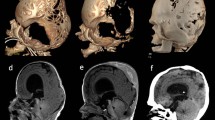Abstract
Up to a few years ago, patients with cloverleaf skull deformity underwent partial surgery to relieve intracranial hypertension with poor functional and aesthetic results, often leading to relapses and reoperations, both in our own experience and in that of other authors. As of 1990, however, we started to use the technique described by Persing et al. to resolve the complex cloverleaf malformation in a single definitive procedure. Five patients, whose ages ranged from 2 months to 5 years, achieved satisfactory results both as regards relief from intracranial hypertension and preservation of visual acuity, and from the aesthetic viewpoint. Surgical approaches and their modifications are described.
Similar content being viewed by others
References
Angle C, McIntire M, Moore R (1967) Clover leaf skull. Am J Dis Child 114:198–204
Cohen M (1972) The Kleeblattschädel phenomenon: sign or syndrome. Am J Dis Child 124:944–1003
Cohen M (1988) Craniosynostosis update 1987. Am J Med Genet Suppl 4:99–148
Galli G (1984) Craniosynostosis. CRC Press, Boca Raton, Fla
Gathman H, Meyer R (1977) Der Kleeblattschädel. Springer, New York Berlin Heidelberg
Goodrich J, Post K, Argamaso R (1991) Plastic techniques in neurosurgery. Thieme, New York Stuttgart
Kroczek R, Muhlbauer W, Zimmermann I (1986) Cloverleaf skull associated with Pfeiffer syndrome. Eur J Pediatr 145:442–445
Marchac D, Renier D (1982) Craniofacial surgery for craniosynostosis. Little, Brown, & Co, Boston, pp 134–156
Muller P, Hoffman H (1975) Cloverleaf skull syndrome. J Neurosurg 43:86–91
Persing J, Edgerton M, Jane J (1989) Scientific foundations and surgical treatment of craniosynostosis. Williams & Wilkins, Baltimore Hong Kong London, pp 205–207
Takano S, Enomoto T, Onizuka H (1989) Cloverleaf skull syndrome with occipital bone cristae. Neurol Med Chir (Toyko) 29:746–752
Turner P, Reynolds A (1980) Generous craniectomy for Kleeblattschädel anomaly. Neurosurgery 6:555–558
Zuleta A, Basauri L (1984) Cloverleaf skull syndrome. Child's Brain 11:418–427
Author information
Authors and Affiliations
Rights and permissions
About this article
Cite this article
Zuccaro, G., Dogliotti, P., Bennum, R. et al. Treatment of cloverleaf skull syndrome. Child's Nerv Syst 12, 695–698 (1996). https://doi.org/10.1007/BF00366153
Issue Date:
DOI: https://doi.org/10.1007/BF00366153




